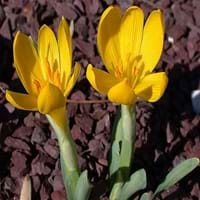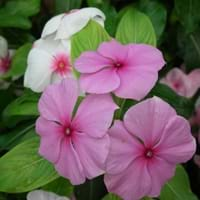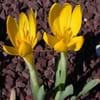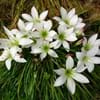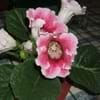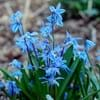Life Span
Perennial
Perennial
Type
Bulb or Corm or Tuber
Flowering Plants, Shrubs
Origin
Southern Europe, Mediterranean, Turkey, Iran, Central Asia, Western Asia
Madagascar
Types
NA
Purple vinca, Vinca, cherry red, strawberry color
Number of Varieties
Not Available
Habitat
countryside, Rural areas
Subtropical climates, Tropical regions
USDA Hardiness Zone
Not Available
4-9
AHS Heat Zone
Not Available
12-1
Sunset Zone
21,22
A1, A2, A3, H1, H2, 1a, 1b, 2a, 2b, 3a, 3b, 4, 5, 6, 7, 8, 9, 10, 11, 12, 13, 14, 15, 16, 17, 18, 19, 20, 21, 22, 23, 24
Habit
Clump-Forming
Clump-Forming
Flower Color
White, Yellow
Magenta, Pink, Rose
Flower Color Modifier
Bicolor
Not Available
Fruit Color
Not Available
Not Available
Leaf Color in Spring
Green, Gray Green
Dark Green
Leaf Color in Summer
Light Green
Dark Green
Leaf Color in Fall
Several shades of Green
Dark Green
Leaf Color in Winter
Light Green
Dark Green
Leaf Shape
Strap shaped
Oval
Plant Season
Spring, Fall, Winter
Fall, Spring, Summer, Winter
Sunlight
Full Sun
Partial shade
Type of Soil
Loam, Sand
Loamy, Sandy, Well drained
The pH of Soil
Neutral, Alkaline
Neutral, Slightly Alkaline
Soil Drainage
Well drained
Well drained
Bloom Time
Early Spring, Late Summer, Early Fall, Fall, Late Winter
Fall, Spring, Summer
Tolerances
Drought
Drought, Pollution, Salt
Where to Plant?
Container, Ground, Pot
Container, Ground, Pot
How to Plant?
By dividing rhizomes, tubers, Corms or bulbs, Offsets
Seedlings, Stem Planting, Transplanting
Plant Maintenance
Medium
Medium
Watering Requirements
Average Water Needs, Do Not over Water, Requires regular watering
Does not require lot of watering, Medium
In Summer
Lots of watering
Lots of watering
In Spring
Moderate
Moderate
In Winter
Average Water
Average Water
Soil pH
Neutral, Alkaline
Neutral, Slightly Alkaline
Soil Type
Loam, Sand
Loamy, Sandy, Well drained
Soil Drainage Capacity
Well drained
Well drained
Sun Exposure
Full Sun
Partial shade
Pruning
Remove damaged leaves, Remove dead branches, Remove dead leaves
Prune ocassionally
Fertilizers
All-Purpose Liquid Fertilizer
All-Purpose Liquid Fertilizer
Pests and Diseases
Cutworms
Botrytis Blight, Canker, Crown rot, Pythium rot, Root rot
Plant Tolerance
Drought
Drought
Flower Petal Number
Single
Single
Foliage Texture
Fine
Medium
Foliage Sheen
Matte
Glossy
Attracts
Cutworms, Flies
Butterflies
Allergy
poisonous if ingested
Intestinal gas, Nausea, Vomiting
Aesthetic Uses
Bonsai, Bouquets, Showy Purposes
Beautification, Showy Purposes
Beauty Benefits
Not Available
Not Available
Environmental Uses
Air purification
Air purification
Medicinal Uses
No Medicinal Use
Chest pain, High blood pressure, Inflammation, Sore throat, Tooth ache, Wounds
Part of Plant Used
Flowers
Whole plant
Other Uses
Used as Ornamental plant
Decoration Purposes, Showy Purposes, Used as Ornamental plant
Used As Indoor Plant
No
Yes
Used As Outdoor Plant
Yes
Yes
Garden Design
Container, Cutflower, Lawns and Turf, Mixed Border, Rock Garden / Wall, Wildflower
Bedding Plant, Container, Edging
Botanical Name
STERNBERGIA
Catharanthus roseus
Common Name
Sternbergia
Madagascar periwinkle or rosy periwinkle
In Hindi
Sternbergia
Periwinkle
In German
Sternbergia
Immergrün
In French
Sternbergia
Pervenche
In Spanish
Sternbergia
Bígaro
In Greek
Sternbergia
μυρτιά
In Portuguese
Sternbergia
Mirta
In Polish
Sternbergia
Barwinek
In Latin
Sternbergia
Periwinkle
Phylum
Tracheophyta
Mollusca
Class
Magnoliopsida
Gastropoda
Order
Asparagales
Geraniales
Family
Amaryllidaceae
Apocynaceae
Genus
Sternbergia
Catharanthus
Clade
Angiosperms, Monocots
Not Available
Tribe
Not Available
Not Available
Subfamily
Amaryllidoideae
Not Available
Importance of Sternbergia Lutea and Periwinkle
Want to have the most appropriate plant for your garden? You might want to know the importance of Sternbergia Lutea and Periwinkle. Basically, these two plants vary in many aspects. Compare Sternbergia Lutea and Periwinkle as they differ in many characteristics such as their life, care, benefits, facts, etc. Every gardener must at least have the slightest clue about the plants he wants to plant in his garden. Compare their benefits, which differ in many ways like facts and uses. The medicinal use of Sternbergia Lutea is No Medicinal Use whereas of Periwinkle is Chest pain, High blood pressure, Inflammation, Sore throat, Tooth ache and Wounds. Sternbergia Lutea has beauty benefits as follows: Not Available while Periwinkle has beauty benefits as follows: Not Available.
Compare Facts of Sternbergia Lutea vs Periwinkle
How to choose the best garden plant for your garden depending upon its facts? Here garden plant comparison will help you to solve this query. Compare the facts of Sternbergia Lutea vs Periwinkle and know which one to choose. As garden plants have benefits and other uses, allergy is also a major drawback of plants for some people. Allergic reactions of Sternbergia Lutea are poisonous if ingested whereas of Periwinkle have Intestinal gas, Nausea and Vomiting respectively. Having a fruit bearing plant in your garden can be a plus point of your garden. Sternbergia Lutea has no showy fruits and Periwinkle has no showy fruits. Also Sternbergia Lutea is not flowering and Periwinkle is flowering. You can compare Sternbergia Lutea and Periwinkle facts and facts of other plants too.
